Resident Crews of the International Space Station (ISS)
![]()
ISS: Expedition 11 |
 |
|
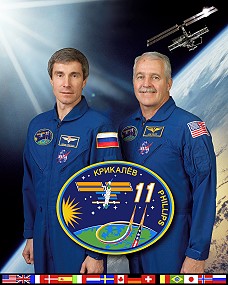
alternative crew photo |
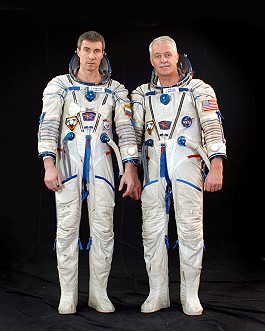
|
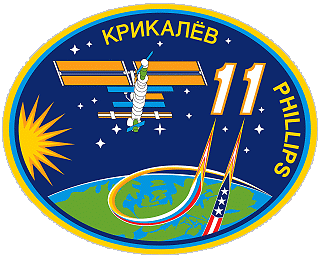 |
 |
||
![]()
Crew, launch- and landing data
| No. | Nation | Surname | Given names | Position | Spacecraft (launch) |
Launch date |
Launch time |
Spacecraft (landing) |
Landing date |
Landing time |
Mission duration |
Orbits |
| 1 | Krikalyov | Sergei Konstantinovich | ISS-CDR | Soyuz TMA-6 | 15.04.2005 | 00:46:25.147 UTC | Soyuz TMA-6 | 11.10.2005 | 01:09:47.8 UTC | 179d 00h 23m 23s | 2818 | |
| 2 | Phillips | John Lynch | Flight Engineer | Soyuz TMA-6 | 15.04.2005 | 00:46:25.147 UTC | Soyuz TMA-6 | 11.10.2005 | 01:09:47.8 UTC | 179d 00h 23m 23s | 2818 |
Backup Crew
| No. | Nation | Surname | Given names | Position |
| 1 | Tyurin | Mikhail Vladislavovich | ISS-CDR | |
| 2 | Tani | Daniel Michio | Flight Engineer |
 |
Expedition Report
|
Expedition 11 launched with
Soyuz
TMA-6 from the Baikonur Cosmodrome and landed 68 km northeast of
Arkalyk. The Expedition 11 officially began with undocking of Russian spacecraft Soyuz TMA-5 on April 24, 2005 at 18:44:40 UTC and Expedition 10 ended. The ISS Expedition 11 was called a "caretaker" crew. Following a two-day solo flight Soyuz TMA-6 docked to ISS on April 17, 2005. Sergei Krikalyov and John Phillips replaced the Expedition 10 crew. European Space Agency Astronaut Roberto Vittori of Italy launched to the Station with the Expedition 11 crew and spent eight days onboard performing scientific experiments as part of the European ENEIDE program. Roberto Vittori returned to Earth with the Expedition 10 crew. He was aboard under a contract between ESA and the Russian Federal Space Agency. The crew performed routine maintenance, repairing work (for example a faulty restraint cable on the exercise treadmill), scientific research, as FOOT experiment (Foot/Ground Reaction Forces During Spaceflight experiment) the Miscible Fluids in Microgravity (MFMG) investigation and so on, practicing photography techniques with digital cameras. These techniques were used to capture high resolution images of Space Shuttle Discovery before docking on the station to control the heat shield of the Shuttle. Progress M-53 was launched at 23:09:34 UTC on June 16, 2005. The spacecraft docked with the Aft port of the Zvezda module at 00:41:31 UTC on 19 June 19, 2005. The docking was conducted using the backup TORU system, under the control of cosmonaut Sergei Krikalyov, due to a power failure at one of the spacecraft's ground control stations. Progress M-53 carried supplies to the International Space Station, including food, water and oxygen for the crew and equipment for conducting scientific research. The freighter remained docked for three months before undocking at 10:25:57 UTC on September 07, 2005 to make way for Progress M-54. It was deorbited at 13:26:00 UTC on September 07, 2005. The spacecraft burned up in the atmosphere over the Pacific Ocean, with any remaining debris landing in the ocean at around 14:12:40 UTC. On July 19, 2005 the crew relocated their Soyuz return spacecraft from one docking port to another to free up a Russian airlock for a future spacewalk. On July 28, 2005 Space Shuttle STS-114 docked with the International Space Station. STS-114 (ISS LF1/MPLM 2-03) was classified as Logistics Flight 1. The flight carried the Raffaello Multi-Purpose Logistics Module, built by the Italian Space Agency. Also, the External Stowage Platform-2, mounting that to the port side of the Quest Airlock. They deployed MISSE-5 to the station's exterior, and replaced one of the ISS's Control Moment Gyroscopes. The CMG and a TPS Repair Box were carried up on the LMC at the rear of the payload bay. The STS-114 mission delivered supplies to the International Space Station. However, the major focus of the mission was testing and evaluating new Space Shuttle flight safety techniques, which included new inspection and repair techniques. The crewmembers used the new Orbiter Boom Sensor System (OBSS) - a set of instruments on a 50-foot (15 m) extension attached to the Canadarm. The OBSS instrument package consists of visual imaging equipment and a Laser Dynamic Range Imager (LDRI) to detect problems with the shuttle's Thermal Protection System (TPS). The crew scanned the leading edges of the wings, the nose cap, and the crew compartment for damage, as well as other potential problem areas engineers wished to inspect based on video taken during lift-off. Discovery's approach to the International Space Station during the STS-114 rendezvous and docking process included an unprecedented maneuver - a back-flip pirouette - enabling Station residents to take digital photographs of the Shuttle's thermal protection system. On the fourth day of the mission, more than 2 ½ years since a Shuttle has delivered supplies to the Station, the crew used the Station's robotic arm to lift an Italian-built cargo module named Raffaello, technically known as a Multi-Purpose Logistics Module (MPLM), out of the Shuttle cargo bay and attached it to the Station. They then began to transfer several tons of supplies and equipment to the Station for use by the Station's Expedition 11 Crew, Commander Sergei Krikalyov and Flight Engineer John Phillips. This was the third trip to the Station for Raffaello, the second of three such cargo carriers to be put into service. Raffaello flew aboard Endeavour on STS-100 and STS-108 in 2001. In addition, Discovery and its crew transferred water to the Station for use in a variety of applications. The first EVA by Stephen Robinson and Soichi Noguchi occurred on July 30, .2005 (6h 50m) for testing thermal protection system repair techniques and installation of the External Stowage Platform-2 Attachment Device (ESPAD) on the space station. After exiting Discovery's airlock, Soichi Noguchi and Stephen Robinson did their initial setup for the spacewalk. This setup period included a trip to the Space Station's Quest airlock on the Station's robotic arm for Soichi Noguchi to open the hatch and provide an emergency entrance point. The crew lock portion of Quest had been depressurized by the Expedition 11 crew the night before. Quest's outer hatch remained open until all three EVAs were completed. Soichi Noguchi closed a thermal cover over the open hatch before returning to Discovery's payload bay to begin the thermal protection repair tests, known as Detailed Test Objective 848 (DTO 848). For DTO 848, the two spacewalkers assisted one another side-by-side in Discovery's cargo bay at a pallet carrying a variety of damaged Shuttle tiles and Reinforced Carbon-Carbon (RCC) samples. Soichi Noguchi and Stephen Robinson had half an hour each to perform their DTO tasks, with 25 additional minutes allocated for cleanup at the tests. Soichi Noguchi worked on tile repair, demonstrating the use of an Emittance Wash Applicator (EWA) and associated tools. The EWA is a dauber-like applicator, used to apply the sticky, caulk-like mixture of fine-grit silicon carbide (SiC) granules and room temperature vulcanizing (RTV) material to exposed tile substrate. Other tools used with this repair technique include foam brushes to cover areas that the larger EWA applicator cannot, and wipes to remove excess material from spacesuits, gloves or tools. His part of the DTO was considered fully successful if one 4-by-4-inch (10-by-10 centimeters) area of exposed substrate is covered. In the "Emittance Wash Applicator dispenses a mixture of fine-grit silicon carbide (SiC) granules and room temperature vulcanizing (RTV) material" application, an emittance wash would be used to repair shallow tile damage. The silicon tiles used in the Shuttle's thermal protection system both reject heat and insulate. The white silicon substrate provides insulation, while the black reaction-cured glass (RCG) coating rejects heat. The ability of a material to reject heat is measured in terms of its "emissivity". The RCG coating on tiles has a high emissivity value, while the white substrate has a lower emissivity value, especially as temperatures rise. The science behind the emittance wash repair involves replacing a damaged tile's coating to restore its ability to reject the high temperatures of atmospheric entry. The emittance wash wicks into the tile substrate, providing an adhesive bond, and a high emissivity, or heat rejection value. For small, shallow areas of damage, replacing the RCG coating with the emittance wash will restore enough heat rejection capability for safe entry. Afterward, Stephen Robinson worked with the RCC crack repair technique. He used a space-hardened caulk gun to dispense a pre-ceramic polymer sealant impregnated with carbon-silicon carbide powder, together known as NOAX (short for Non-Oxide Adhesive eXperimental). Using one of two caulk guns in the crack repair kit, Stephen Robinson dispensed the material onto one of two pallets, similar to those used for plastering. He then used one of two scrapers, similar to putty knives, to work the crack repair material into a pre-damaged RCC sample mounted in the DTO pallet. There were four cracks and two gouges on the RCC sample, and his portion of the DTO was deemed successful if one crack and one gouge are repaired. NASA materials experts have estimated that cracks or coating damage as small as 2 inches (5 centimeters) long and .02 of an inch (0.5 mm) wide in some locations on the Shuttle's wing leading edge could result in catastrophic damage to that wing. The crack filling method was designed to fix the type of damage most likely to be caused by small pieces of foam coming off the redesigned external tank. NOAX can be used at any RCC location, and does not require any physical modification of the RCC before affecting a repair. It was expected to repair cracks or coating losses up to four inches long, but cannot be used to repair holes. While NOAX initially was thought to need a heater to prepare the RCC surface for application and post-application curing, recent tests on the ground have shown promising results that heating the damaged area and the material may not be required. No heaters were used in the STS-114 tests. After the DTO 848 tasks were complete, the spacewalkers worked to clean up the work area around the DTO pallet before moving on to their assembly get-ahead work. The lid to the sample box was left open until the end of the EVA to allow the OBSS sensors to scan the damaged samples in the box. Removing the External Stowage Platform-2 (ESP-2) Attachment Device (ESPAD) from its Lightweight Multi-Purpose External Support Structure (MPESS) and installing it on the side of the Space Station airlock was the first of those get-ahead tasks. ESPAD is a two-part mechanism, with one part containing the active ESPAD claw, which will provide a temporary structural connection for the ESP-2 when it is first installed. The other half is passive and will remain connected to ESP-2, eventually being grabbed by the claw and then firmly bolted to the active member. They were assisted by James Kelly and Wendy Lawrence inside the Space Station, operating the Station's robotic arm, and by Andrew Thomas inside the Shuttle, who relayed information and instructions from Mission Control. Stephen Robinson's first job was to install an Articulating Portable Foot Restraint (APFR) into the Latching End Effector (LEE) of the Station's 80-foot-long robotic arm. As a free-floater still, he verified that the ESPAD claw is open. He moved a pivoting strut out of the way so that he could remove the first of three bolts which hold the active ESPAD in place for launch. He returned the strut to its original position, and then used a Pistol Grip Tool (PGT), which is a portable drill modified for use in space, to release mounting locks for the Enhanced Universal Truss Attachment System (EUTAS) that was used to attach the active ESPAD member to the airlock structure. The mounting locks were installed pre-flight to prevent vibrations from damaging the EUTAS mechanism. The EUTAS used two knuckled hand-tightening knobs; both could gimble and one could slide to ensure good alignment with the structural members to which they were attached. Once the EUTAS locks were released, he stepped into the foot restraint on the end of the Station's robotic arm and used the PGT to loosen the last two ESPAD launch bolts. After separating the active and passive members, the Station arm was commanded to move Stephen Robinson and the ESPAD from the cargo bay to the Quest airlock trunnions and soft dock the ESPAD with Soichi Noguchi available for guidance. Stephen Robinson hand-tightened the two EUTAS bolts and verified they were tightened well enough to temporarily hold it in place. Then, he used the PGT to finish tightening the bolts and engaged their locking mechanisms. Soichi Noguchi deployed the strut and attached it to a fitting on the Quest airlock. At this point, the ESPAD was ready to structurally accept the ESP-2 on the third spacewalk of the mission. During this same period, Soichi Noguchi's first job was to pre-route the 20-foot-long (6.1 meters) primary cable that will connect the ESPAD to power connections on the end cone of the Unity connecting module. First, he collected the primary and secondary ESP-2 cables from their launch stowage location in the cargo bay and moved hand-over-hand via handrails to the junction of the Unity module and the Station's truss structure near the Destiny module. At the Crew Equipment Translation Aid (CETA) spur, which bridges the gap between Unity and the truss, he temporarily stowed the secondary cable and moved to the Unity end cone adjacent to Destiny's end cone with the primary cable. He connected one end of the primary cable to a jack on Unity and stowed the rest of the cable on a handrail for later attachment on EVA-3. Next, Soichi Noguchi moved back to the Quest airlock, opened the thermal cover, and retrieved an Orbital Replacement Unit (ORU) bag containing a Global Positioning System (GPS) antenna and another bag containing Control Moment Gyroscope (CMG) get-ahead equipment and stowed them at the Station toolbox on the side of the airlock. With this complete, he moved to the ESPAD installation location to help Stephen Robinson. On July 30, 2005, NASA announced that STS-114 would be extended for one day, so that Discovery's crew could help the ISS crew maintain the station while the shuttle fleet is grounded. The extra day was also used to move more items from the shuttle to the ISS, as uncertainty mounted during the mission as to when a shuttle will next visit the station. The orbiter's arrival also gave the nearly 200-ton space station a free altitude boost of about 4,000 feet (1,220 m). The station loses about 100 feet (30 m) of altitude a day. The second EVA was performed by Stephen Robinson and Soichi Noguchi on August 01, 2005 (7h 14m) to replace a failed International Space Station attitude control gyroscope. The sole objective of EVA-2 was the removal and replacement of a failed Control Moment Gyroscope from the Station's Z1 truss. The old CMG failed in June 2002; since then, the Station had used the remaining three CMGs to maintain and adjust the Station's attitude, or orientation, relative to the Earth. At this stage of the assembly sequence, two CMGs are sufficient to control the Station's attitude. The third functioning CMG provides the necessary amount of redundancy, or backup. However, later in the assembly sequence, the Station will become less symmetrical and a minimum of three CMGs will be needed to maintain attitude. So, four healthy gyroscopes will be needed to control the Station's orientation relative to the Earth and offer a backup if another gyroscope were to fail. Each gyroscope weighs 620 pounds (281 kg) and is about the size of a washing machine. Each has a reaction wheel that spins at a constant speed of 6,600 revolutions per minute. Flight controllers on the ground can use guidance and navigation software to reposition the direction of the gyros' spin axes. Repositioning these axes causes the CMGs to generate torque. This torque is transferred to the Station's structure, counteracting the gravitational and drags forces to maintain attitude or to induce changes to the Station's orientation. After exiting the Shuttle airlock, Soichi Noguchi and Stephen Robinson made sure their spacesuits and tools are in order and worked their way hand-over-hand to the Z1 truss. Soichi Noguchi stepped into an APFR on the Space Station's robotic arm, which again was controlled by James Kelly and Wendy Lawrence. The pair worked together to peel back and secure the multilayer insulation thermal shroud covering CMG-1. After receiving confirmation from Andrew Thomas inside the Shuttle and Mission Control, Soichi Noguchi disconnected four power and data cables and tied them out of the way. Next, they loosened the bolts holding the CMG in its support structure; Soichi Noguchi loosened four bolts and Stephen Robinson two bolts using PGTs. When all six were loosened, Stephen Robinson wiggled the CMG to make sure it is not binding. Each spacewalker then removed two launch shims designed to provide a snug fit for the CMG in its support structure. Soichi Noguchi removed four captive bolts and Stephen Robinson two, then lifted the CMG out of its cradle. Stephen Robinson used his helmet-mounted video camera to send inspection views of the cavity to Mission Control for evaluation. James Kelly and Wendy Lawrence used Canadarm2 to swing Soichi Noguchi and the failed CMG back to Discovery's payload bay and the Lightweight Mission Peculiar Equipment Support Structure Carrier (LMC). While Soichi Noguchi was in transit, Stephen Robinson moved back to the cargo bay and position two "ball stacks", which were temporary holding arms, to the CMG carrier. When Soichi Noguchi arrived with the old CMG, the pair secured it to one of these ball stacks. Still on the end of the Station's robotic arm, Soichi Noguchi held the new CMG while Stephen Robinson disconnected it from the ball stack holding it to the CMG carrier. Arm operators maneuvered Soichi Noguchi and the new CMG to the Z1 truss, where Soichi Noguchi inserted the new CMG into the empty cavity. Meanwhile, Stephen Robinson moved back to the Z1, managing tethers and reporting clearances to help the robotic arm operators. Once the new CMG was "soft docked" in its cavity (no shims are required), Soichi Noguchi tightened four bolts and Stephen Robinson two. After applying the right amount of torque to the bolts using PGTs, the pair secured the new attitude control device. In careful coordinating with ground controllers, Soichi Noguchi mated four connectors to the jacks in the Z1 truss. He and Stephen Robinson then reinstalled the thermal shroud over the new CMG, reinstalled the floodlight, and moved back to the cargo bay for cleanup and return to the Shuttle airlock. The third and final EVA by Stephen Robinson and Soichi Noguchi was conducted on August 03, 2005 (6h 01m) to attach a massive external tool box to the space station's Quest airlock module, mounting an experiment package on the top of the station's solar array truss, and remove two "gap fillers" sticking up between heat shield tiles on Discovery's belly. On tap are installation of a camera and illuminator package on the port truss structure of the Station, installation of ESP-2, retrieval of two Materials International Space Station Experiment (MISSE) packages and the installation of one new package, MISSE 5 - the first such experiment to have battery power and wireless data transmission capabilities. After exiting the Shuttle airlock with the camera group and ensuring their suits and tools were ready, Soichi Noguchi went to the Video Stanchion Support Assembly (VSSA) in the cargo bay to retrieve the stanchion, while Stephen Robinson removed an orbiter power cable from ESP-2 in preparation for its removal. Soichi Noguchi removed two launch bolts and floated with the stanchion to the port side of the Shuttle's docking system, positioning it so that Stephen Robinson could remove several bolts holding a connector-protecting dummy box. Next, Stephen Robinson installed the camera group in its stanchion and secured it with three bolts using a PGT. Together, they moved hand-over-hand to the Camera Position 9 worksite at the end of the P1 truss on the Earth-facing side. Soichi Noguchi positioned the stanchion and used a PGT to engage one bolt that anchors the package to the truss. While Stephen Robinson removed one end of the power and data cables from dummy jacks on the VSSA, Soichi Noguchi removed dust caps from the real jacks on the P1 truss and then mated the three cable connectors to the appropriate jacks. Stephen Robinson removed a protective cover from the illuminator and unlocked the camera's pan and tilt mechanism. The last planned task of EVA 3 was the retrieval of two materials exposure experiments and the installation of a new one. Stephen Robinson used handrails to move to the end of the Quest crew lock and took photos of the MISSE 2 experiment package before closing the experiment housing, releasing two PIP pins and removing the suitcase-like package. He placed MISSE 2 in the Quest crew lock for temporary storage, then went to the MISSE 1 location. There, on the Earth-facing side of one of the dog house-shaped oxygen tanks mounted on the exterior of Quest's equipment lock, he performed the same steps on MISSE 2 and closed the airlock thermal cover. Meanwhile, Soichi Noguchi went to the Station airlock and retrieved a spare tether, a clamp and MISSE 5. Moving along handrails, he travelled to the uppermost point on the Space Station, the top of the P6 truss that holds the two large banks of American solar arrays. There, he installed the clamp on a handrail on the P6's aft trunnion and locked MISSE 5 in place. Soichi Noguchi turned the suitcase-like experiment inside-out, exposing its material samples to space. He ensured that the wireless antennas that were used to transfer data were deployed. Those antennas function in the same way that the Station's amateur radio antennas do, and will allow commands to be sent to the experiment package. Telemetry from the experiments will be transmitted every three minutes to the United States Naval Academy near Washington, D.C. or other amateur radio receiving stations around the world. Soichi Noguchi verified that the electronics were turned on before heading back to the Quest hatch. The removal of two "gap fillers" sticking up between heat shield tiles on Discovery's belly was an additional task. If it were not possible to pull the fillers out then the protruding sections could have been simply cut off. The gap fillers are made of a cloth impregnated with ceramic - they are stiff and can be easily cut with a tool similar to a hacksaw blade. Protruding gap fillers are a problem because they disrupt the normally laminar air flow under the orbiter during reentry, which causes turbulence at lower speeds. A turbulent air flow results in a mixing of hot and cold air which can have a major effect on the shuttle temperature. According to NASA, the gap fillers, which each serve different purposes, are not required for reentry. One filler prevents "chattering" of tiles during ascent, which would occur due to the sonic booms from the noses of the solid rocket boosters and the external fuel tank. The other, in a different location where there is a wider gap between tiles, simply functions to reduce the gap size between tiles, which in turn reduces heat transfer to the shuttle. Even without this filler NASA did not expect the increased heat to cause a problem during reentry (it is present to avoid a level of heating which would only be problematic if experienced many times over a vehicle's design life). Since the gap fillers are not necessary for re-entry, it was acceptable to simply pull them out. An overview of the situation, including procedures for dealing with the protrusions were sent electronically to the crew and printed aboard the shuttle. On August 06, 2005 STS-114 backed away from the ISS to a distance of about 450 feet (137.2 meters), where James Kelly initiated a maneuver to fly the Shuttle directly above the Station. At that point, he fired Discovery's jets to depart the vicinity of the Station for the final time. The only EVA in this expedition was performed by Sergei Krikalyov and John Phillips on August 18, 2005 (4h 58m) to change out a Russian biological experiment, retrieve some radiation sensors, remove a Japanese materials science experiment, photograph a Russian materials experiment, install a television camera and relocate a grapple fixture. On September 07, 2005 the unpiloted Progress spacecraft M-54 undocked from the station and was deorbited, to make way for the arrival of Progress M-55 which docked in September 2005 and transferred around 2300 kg of cargo, (fuel, water, and dry cargo including oxygen generators) to the station. Progress M-55 was launched at 13:07:54 UTC on September 08, 2005. The spacecraft docked with the Aft port of the Zvezda module at 14:42:03 UTC on September 10, 2005. Progress M-54 carried supplies to the International Space Station, including food, water and oxygen for the crew and equipment for conducting scientific research. It also carried the radio transmitter for the RadioSkaf satellite, which was assembled aboard the ISS using a retired Orlan spacesuit. The freighter remained docked for six months before undocking at 10:06:10 UTC on March 03, 2006. It was deorbited at 13:05:00 UTC on March 03, 2006. The spacecraft burned up in the atmosphere over the Pacific Ocean, with any remaining debris landing in the ocean at around 13:52:18 UTC. Advanced Diagnostic Ultrasound in Microgravity (ADUM) will be used to determine the ability of minimally trained Station crewmembers to perform advanced ultrasound examinations after using a computer-based training program. The crewmember being "examined" will be immobilized on the Crew Medical Restraint System. The other crewmember will then examine him using the Human Research Facility ultrasound equipment under the direction of a sonographer in the Mission Control Center in Houston. Verification of these advanced ultrasound techniques and telemedicine strategies could have widespread applications in emergency and rural care situations on Earth. Effect of Prolonged Spaceflight on Human Skeletal Muscle (Biopsy): To determine the time course and extent of functional and structural change in limb skeletal muscle with prolonged spaceflight, establish the cellular mechanisms of the observed functional alterations, and calculate the new steady state that would likely be reached in calf muscle structure and function following a trip to Mars and back. By allowing photographs to be taken from space, the Crew Earth Observations (CEO) experiment provides people on Earth with image data needed to better understand our planet. The photographs - taken by crewmembers using handheld cameras - record observable Earth surface changes over a period of time, as well as more fleeting events such as storms, floods, fires and volcanic eruptions. Chromosomal Aberrations in Blood Lymphocytes of Astronauts: Cosmic radiation is a major risk factor in human spaceflight. This study will assess the mutagenic impact of ionizing radiations in crewmembers by analyzing chromosomal aberrations in blood lymphocytes, from pre- and post-flight blood samples. Previous investigations studying chromosomal aberrations were conducted using conventional block stained Giemsa preparations. A disadvantage of this method is that only unstable aberrations, which are of less biological significance, can be detected. Dust Aerosol Measurement Feasibility Test (DAFT): The DAFT experiment consists of three commercially developed pieces of hardware: DAFT-1 (DustTrak), DAFT-2 (P-Trak), and DAFT-4 (unmodified P-Trak). DAFT-3 is a collection of additional materials for the experiment including bags, some Arizona Road Dust, and a fill mechanism which inflates the bags and regulates pressure in the system. DAFT's main objective is to test the P-Trak's ability to make air quality measurements in a microgravity environment due to its potential susceptibility to gravity. The P-Trak is a handheld device that counts particles in the atmosphere. The DustTrak verifies the P-Trak device and measures mass per unit volume of particles floating in the atmosphere. EarthKAM (Earth Knowledge Acquired by Middle school students) is a NASA education payload that enables students to photograph and examine Earth from a space crew's perspective. Epstein-Barr: Space Flight Induced Reactivation of Latent Epstein-Barr Virus: This experiment is designed to examine the mechanisms of space flight induced alterations in human immune function and dormant virus reactivation. Specifically, this study will determine the magnitude of immunosuppression as a result of space flight by analyzing stress hormones, measuring the amount of Epstein-Barr virus activity, and measuring white blood cells' virus-specific activity. FOOT Reaction Forces During Spaceflight: The heart of the FOOT experiment is an instrumented suit called the Lower Extremity Monitoring Suit (LEMS). This customized garment is a pair of Lycra cycling tights incorporating 20 carefully placed sensors and the associated wiring, control units and amplifiers. LEMS will enable the electrical activity of muscles, the angular motions of the hip, knee and ankle joints, and the force on both feet to be measured continuously. Information from the sensors can be recorded for up to 14 hours on a small wearable computer. Measurements will also be made of the arm muscles. The crewmembers will put the suit on in the morning before they start their work day and, after calibration, they will go about their regular daily activities. Throughout the day, the sensors will capture data that will allow researchers to characterize differences between use of the arms and legs on Earth and in space. The research objective of the ASI Facility Hand Posture Analyzer (HPA) is to investigate the performance degradation of the human upper limb muscle-skeletal apparatus and its morphological-functional modifications during long-term exposure to weightlessness and to study the role of gravity in the planning-execution hierarchy of reaching, grasping, manipulating and transporting objects. Human Research Facility Rack 2: HRF racks provide Space Station services and utilities to experiments and instruments installed in the racks. These include electrical power, command and data handling, cooling air and water, pressurized gases and vacuum. The design accommodates interchangeable drawer-mounted instruments and provides basic utilities to on-board experiments. Behavioral Issues Associated with Isolation and Confinement: Review and Analysis of ISS Crew Journals: The purpose of this experiment is to collect behavioral and human factors data for analysis, with the intention of furthering our understanding of life in isolation and confinement. The objective of the experiment is to identify equipment, habitat and procedural features that help humans adjust to isolation and confinement and remain effective and productive during future long-duration space expeditions. The method used in the experiment is analyzing the content of journals maintained by International Space Station crews for this purpose. Acquisition & Analysis of Medical & Environment Data Aboard the International Space Station: Providing a quiescent microgravity, or low-gravity, environment for fundamental scientific research is one of the major goals of the International Space Station Program. However, tiny disturbances aboard the Space Station mimic the effects of gravity, and scientists need to understand, track and measure these potential disruptions. Two accelerometer systems developed by the Glenn Research Center are being used aboard the Station to measure the acceleration environment. Operation of these systems began with Expedition 2 and will continue throughout the life of the Station. The Space Acceleration Measurement System II (SAMS-II) measures accelerations caused by vehicle, crew and equipment disturbances. To complement the SAMS-II measurements, the Microgravity Acceleration Measurement System (MAMS) records accelerations caused by the aerodynamic drag created as the Station moves through space. It also measures accelerations created as the vehicle rotates and vents water. These small, quasi-steady accelerations occur in the frequency range below 1 Hertz. The Materials on the International Space Station Experiment (MISSE) Project is a NASA/Langley Research Center-managed cooperative endeavor to fly materials and other types of space exposure experiments on the Space Station. The objective is to develop early, low-cost, non-intrusive opportunities to conduct critical space exposure tests of space materials and components planned for use on future spacecraft. Promoting Sensorimotor Response Generalizability: A Countermeasure to Mitigate Locomotor Dysfunction After Long-duration Spaceflight (MOBILITY): Astronauts returning from spaceflight can experience difficulty walking as the brain must readapt to programming body movements in a gravity environment. The MOBILITY experiment will use tests taken before and after a long-duration spaceflight to determine whether a specific training regimen using the Station's treadmill can help astronauts recover more quickly when they return to Earth. Specifically, do astronauts who use this unique treadmill workout in space readjust more quickly when once again exposed to the effects of gravity? Protein Crystal Growth (PCG): The fundamental goal for growing biological macromolecular crystals is to determine their three-dimensional structure in order to understand the biological processes in which they are involved. Scientists select macromolecules, crystallize them, and analyze the atomic details - often by using X-ray crystallography. By sending an intense X-ray beam through a crystal, scientists try to determine the three-dimensional atomic structure of the macromolecule. Understanding these structures may impact the studies of medicine, agriculture, the environment and other biosciences. Every chemical reaction essential to life depends on the function of these compounds. Passive Observatories for Experimental Microbial Systems in Microgravity (POEMS): This experiment uses a new system for microbial cultivation in the spaceflight environment to observe the generation and maintenance of genetic variation within microbial populations in microgravity. POEMS will contain experiments studying the growth, ecology and performance of diverse assemblages of microorganisms in space. Renal Stone Renal Stone Risk During Spaceflight: Assessment and Countermeasure Validation: This experiment examines the risk of renal (kidney) stone formation in crewmembers during the pre-flight, in-flight and post-flight timeframes. Potassium citrate (K-cit) is a proven ground-based treatment for patients suffering from renal stones. In this study, K-cit tablets will be administered to astronauts and multiple urine samples will be taken before, during and after spaceflight to evaluate the risk of renal stone formation. From the results, K-cit will be evaluated as a potential countermeasure to alter the urinary biochemistry and lower the risk for potential development of renal stones in microgravity. This study will also examine the influence of dietary factors on the urinary biochemistry, investigate the effect flight duration on renal stone formation and determine how long after spaceflight the risk exists. Serial Network Flow Monitor (SNFM): This experiment studies the function of the computer network on board the International Space Station. On-orbit packet statistics are captured and used to validate ground based medium rate data link models and enhance the way that the LAN is monitored. This information will allow monitoring and improvement in the data transfer capabilities of on orbit computer networks. A Comprehensive Characterization of Microorganisms and Allergens in Spacecraft (Swab): Generic techniques will be used for the first time to comprehensively evaluate the microbes, including pathogens, on the Space Station, and how the microbial community changes as spacecraft visit and modules are added. The Soyuz spacecraft is composed of three elements attached end-to-end - the Orbital Module, the Descent Module and the Instrumentation/Propulsion Module. The crew occupied the central element, the Descent Module. The other two modules are jettisoned prior to re-entry. They burn up in the atmosphere, so only the Descent Module returned to Earth. Having shed two-thirds of its mass, the Soyuz reached Entry Interface - a point 400,000 feet (121.9 kilometers) above the Earth, where friction due to the thickening atmosphere began to heat its outer surfaces. With only 23 minutes left before it lands on the grassy plains of central Asia, attention in the module turned to slowing its rate of descent. Eight minutes later, the spacecraft was streaking through the sky at a rate of 755 feet (230 meters) per second. Before it touched down, its speed slowed to only 5 feet (1.5 meter) per second, and it lands at an even lower speed than that. Several onboard features ensure that the vehicle and crew land safely and in relative comfort. Four parachutes, deployed 15 minutes before landing, dramatically slowed the vehicle's rate of descent. Two pilot parachutes were the first to be released, and a drogue chute attached to the second one followed immediately after. The drogue, measuring 24 square meters (258 square feet) in area, slowed the rate of descent from 755 feet (230 meters) per second to 262 feet (80 meters) per second. The main parachute was the last to emerge. It is the largest chute, with a surface area of 10,764 square feet (1,000 square meters). Its harnesses shifted the vehicle's attitude to a 30-degree angle relative to the ground, dissipating heat, and then shifted it again to a straight vertical descent prior to landing. The main chute slowed the Soyuz to a descent rate of only 24 feet (7.3 meters) per second, which is still too fast for a comfortable landing. One second before touchdown, two sets of three small engines on the bottom of the vehicle fired, slowing the vehicle to soften the landing. On October 03, 2005 Russian spacecraft Soyuz TMA-7 brought the Expedition 12 to the station. Finally, the station command changed from Russian cosmonaut Sergei Krikalyov to US astronaut William McArthur. Expedition 11 officially ended with undocking of Soyuz TMA-6, carrying Sergei Krikalyov and John Phillips, on October 10, 2005 at 21:49:14 UTC. During the stay on board of the ISS the crew of Expedition 11 carried out the following scientific experiments: ADUM (Advanced Diagnostic Ultrasound in Microgravity), ARISS (Amateur Radio on the International Space Station), Biodegradation (Initial stage of Biodegradation and Biodeterioration in Space), Bioekologia (Generation of High Efficiency of Microorganisms for the Production of Preparations of Biodegradable Oil, Organophosphorus Material, Measures for the Protection of Plants, as well as, of Exopolysaddharides Uses in the Petroleum Industry), Biopsy (Effect of Prolonged Space Flight on Human Skeletal Muscle), Biorisk (Influence of Factors of the Space Environment on the Condition of the System of Microorganisms-Hosts Relating to the Problem of Environmental Safety of Flight Techniques and Planetary Quarantine), Biotest (Biochemical Status of Humans in Long Duration Space Flight), BOP (Bone Proteomics), Brados (Acquisition of Data About the Radiological, Electromagnetic and Different Physical Environments on Board ISS, and Their Effects on the Safety of the Crew, Space Equipment and Materials), Cardio-ODNT (Dynamics of the Main Factors of Cardiac Function, of Central and Regional Circulation in Rest and During the Influence of Lower Body Negative Pressure), CEO (Crew Earth Observations), Chromosome-1 (Chromosomal Aberrations in Blood Lymphocytes of Astronauts-1), Clinical Nutrition Assessment (Clinical Nutrition Assessment of ISS Astronauts, SMO-016E), Diatomeya (Stability of Geographical Position and Configuration of Borders of Bioproductive Water Zones of the World Oceans, Observations by Orbition Station Crews), Diurez (Fluid and Electrolyte Metabolism and Hormonal Regulaltion of Fluid Volume), EarthKAM (Earth Knowledge Acquired by Middle School Students), Ekon (Experimental Survey on Evaluating the Possibility of Using th Russian Segment of ISS for Environmental Inspection of Work Areas of Various Facilities (Features)), Environmental Monitoring (Environmental Monitoring of the International Space Station), EPO-Demos (Education Payload Operation - Demonstrations), Epstein-Barr (Space Flight Induced Reactivation of Latent Epstein-Barr Virus), ETD (Eye Tracking Device), Farma (Characteristics of Pharmacological Responses (absorption, distribution and elimination of acetominophene) in Long Duration Space Flight), Fischer Rat Thyroid Low Serum 5 (Fischer Rat Thyroid Low Serum 5%), FMVM (Fluid Merging Viscosity Measurement), Foot (Foot Reaction Forces During Space Flight), Gematologia (Morphofunctional Characteristic of Blood Cells and the Intensity of Erythropoiesis in Humans by the Influence of Factors of Space Flight), HPA (Hand Posture Analyzer), Identifikatsia (Identification of the Sources of Dynamic Loads on ISS), Inflight Education Downlinks (International Space Station Inflight Education Downlinks), Interleukin-K (Production of Hight Quality Crystals of Interleukin -1Alpha, -1Beta and Receptor of Antagonist of Interleukin-1), ISS Acoustics (International Space Station Acoustic Measurement Program), Journals (Behavioral Issues Associated with isolation and Confinement: Review and Analysis of Astronaut Journals), Kromka (Verification of the Effectiveness of Devices for the Protection of the Exterior Surface of ISS from Contaminants Deposited by Pulsed Cycling of Liquid-Jet), Latent Virus (Incidence of Latent Virus Shedding During Space Flight), Meteoroid (Recording Meteoroidal and Technogenic Particles on the External Surface of the Service Module of the Russian Segment of ISS), Mezhkletochnoe Vzaimodeistvie (Intercellular Interactions in Space Flight), MFMG (Miscible Fluids in Microgravity), Microspace (Microbial Life in Space: Response to Environmental Factors in a Space Vehicle), Mimetik-K (Crystalization of antigen Binding Fragment of Monoclonalical Antibody to Glucosaminilmuramildepeptide), MISSE-1 and 2 (Materials International Space Station Experiment - 1 and 2), MISSE-5 (Materials International Space Station Experiment - 5), Mobility (Promoting Sensorimotor Response Generalizability: A Countermeasure to Mitigate Locomotor Dysfunction After Long-Duration Space Flight), MOP (Motion Perception: Vestibular Adaptation to G-Transitions), OVAR (Off-Vertical Axis Rotation: Eye Movements and Motion Perception Induced By Off-Axis Rotation at Small Angles of Tilt After Spaceflight, DSO 499), PCG-STES-RGE (Protein Crystal Growth-Single Locker Thermal Enclosure System-Regulation of Gene Expression), PCG-STES-SA (Protein Crystal Growth-Single Locker Thermal Enclosure System-Science and Applications of Facility Hardware for Protein Crystal Growth), Pilot (Individual Characteristics of Psychophysiological Regulatory Status and Reliaility of Professional Activities of Cosmonauts in Long Duration Space Flight), Plasma-MKS (Plasma-ISS: Examination of Plasmic Environments on the External Surface of ISS Through the Characterization of Optical Radiance), Plasma Crystal (Dusty and Liquid Plasma Crystals in Conditions of Microgravity), Plasma Interaction Model (Analysis of International Space Station Plasma Interaction), PMZ (Bioavailability and Performance Effects of Promethazine During Space Flight), Profilaktika (Mechanisms of Action and Influence, and Effectiveness of Various Methods of Phrophylaxis Directed Toward Prevention of Disturbances of the Human Locomotion System in Weightlessness), Prognoz (Development of a Method of Operational Prediction of Work Load on Crew Piloting Objectives), Pulse (Vegatative (Autonomic) Regulation of the Cardio-Respiratory System of Humans in Conditions of Weightlessness), Rastenia (Growth and Development of Higher Plants through Multiple Generations), Regeneratsia (Effect of Weightlessness on Processes of Regeneration by Electrophysiological and Morphological Factors), Relaksatia (Processes of Relaxation in the Ultraviolet Band Spectrum by High Velocity Interaction of Exhaust Products on ISS), Renal Stone (Renal Stone Risk During Spaceflight: Assessment and Countermeasure Validation), ROKVISS (Robotic Component Verification on the ISS: Verification of Lightweight Robotic Hinge Elements in Space), SEM (Space Experiment Module), SKR (Skorpion: Development and Acquisition of Multifunctional Control-Measurement Device for Controlling the Environment of Scientific Experiments Inside a Pressurized Station), Sleep-Short (Sleep-Wake Actigraphy and Light Exposure During Spaceflight-Short), SNFM (Serial Network Flow Monitor), Sprut-MBI (Determination of Intracellular and Extracellular Fluid Volume in Humans in Space Flight), Statokonia (Growth Potency of Statoconia (Otoliths) in the Organ of Equilibrium of Gastropod Mollusks in Weightlessness), SVS (CBC: Self-Propogating Hyperthermal Synthesis in Space), Toksichnost (Development of a Metod of Express Monitoring of Toxicity of Water in Space Flight), Uragan (Hurricane: Experimental Development of Groundbased System of Monitoring and Predicting the Progression of a Naturally Occurring Technogenic Catastrophe), Vaktsina-K (Structural Study of Protein Candidats in a Vaccine for AIDS on Earth and in Space), Volny (Waves: Observation in near Infrared Spectral Band Undulatory Disturbance in the Middle Atmosphere Layers of the Earth of Technogenic and Naturally Occurring Origin). |
EVA data
| Name | Start | End | Duration | Mission | Airlock | Suit | |
| EVA | Noguchi, Soichi | 30.07.2005, 09:46 UTC | 30.07.2005, 16:36 UTC | 6h 50m | STS-114 | ISS - Discovery | EMU No. 3017 |
| EVA | Robinson, Stephen | 30.07.2005, 09:46 UTC | 30.07.2005, 16:36 UTC | 6h 50m | STS-114 | ISS - Discovery | EMU No. 3004 |
| EVA | Noguchi, Soichi | 01.08.2005, 08:42 UTC | 01.08.2005, 15:56 UTC | 7h 14m | STS-114 | ISS - Discovery | EMU No. 3017 |
| EVA | Robinson, Stephen | 01.08.2005, 08:42 UTC | 01.08.2005, 15:56 UTC | 7h 14m | STS-114 | ISS - Discovery | EMU No. 3004 |
| EVA | Noguchi, Soichi | 03.08.2005, 08:48 UTC | 03.08.2005, 14:49 UTC | 6h 01m | STS-114 | ISS - Discovery | EMU No. 3017 |
| EVA | Robinson, Stephen | 03.08.2005, 08:48 UTC | 03.08.2005, 14:49 UTC | 6h 01m | STS-114 | ISS - Discovery | EMU No. 3004 |
| Name | Start | End | Duration | Mission | Airlock | Suit | |
| EVA | Krikalyov, Sergei | 18.08.2005, 19:0? UTC | 18.08.2005, 23:59 UTC | 4h 58m | ISS-11 | ISS - Pirs | Orlan-M No. 25 |
| EVA | Phillips, John | 18.08.2005, 19:0? UTC | 18.08.2005, 23:59 UTC | 4h 58m | ISS-11 | ISS - Pirs | Orlan-M No. 27 |
Relocations of Manned Spacecrafts
| Spacecraft | from | Undocking | Time UTC | to | Redocking | Time UTC |
| Soyuz TMA-6 | ISS - Pirs | 19.07.2005 | 10:38:10 | ISS - Zarya | 19.07.2005 | 11:07:59 |
ISS Assembly
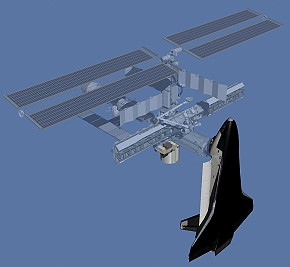 |
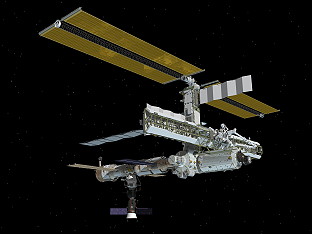 |
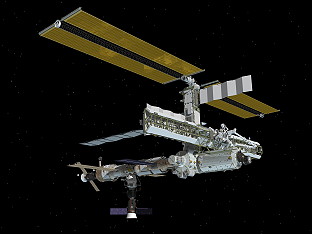 |
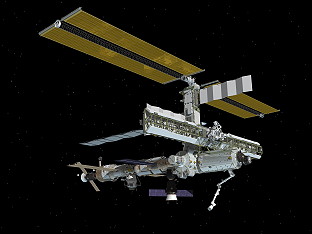 |
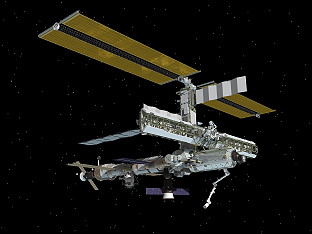 |
|
Photos / Graphics
 |
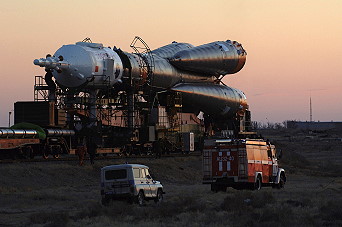 |
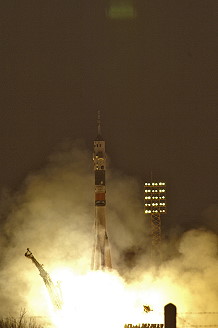 |
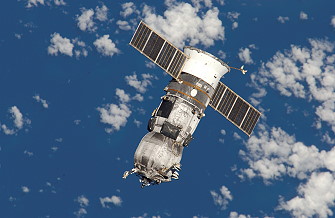 |
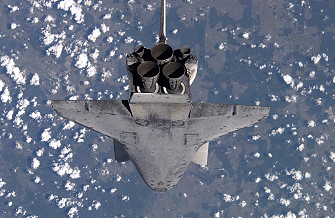 |
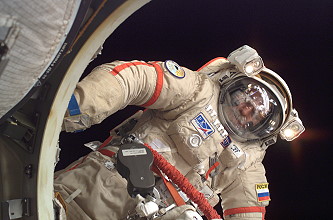 |
 |
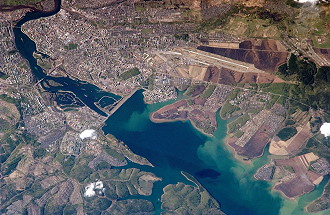 |
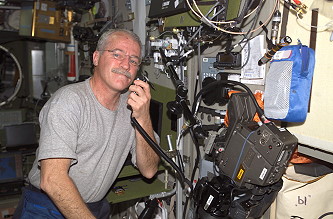 |
 |
 |
 |
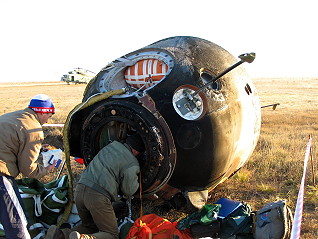 |
|
more Earth observation photos |
|
more EVA photos |
|
more onboard photos |
|
| © |  |
Last update on November 06, 2020.  |
 |